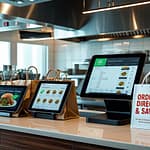Key Takeaways:
- Implement a first-in, first-out (FIFO) system to ensure food freshness and reduce waste.
- Regularly audit your inventory to keep track of what’s in stock and identify patterns of use.
- Invest in inventory management software to streamline operations and improve accuracy.
- Organize your kitchen layout to optimize space and accessibility of frequently used items.
- Train staff on effective inventory management practices to maintain consistency and efficiency.
Inventory Hacks Every Busy Kitchen Needs
Boost kitchen efficiency with these inventory secrets
Running an efficient kitchen in the restaurant industry is like conducting an orchestra. Every ingredient, tool, and team member must be in perfect harmony to deliver a stellar dining experience. Yet, amid the daily hustle, inventory management often slips through the cracks. Poor inventory practices can lead to wasted ingredients, increased costs, and frustrated team members. Fortunately, implementing a few simple inventory management hacks can transform kitchen chaos into a streamlined, profitable operation.
Why Inventory Management Matters
Inventory management isn’t just about counting ingredients; it’s about optimizing your resources, reducing costs, and enhancing kitchen efficiency. Effective inventory management helps identify waste patterns, forecast ingredient usage, and streamline ordering processes. The result? Less food waste, lower costs, and happier customers.
- Reduced food waste and spoilage
- Accurate forecasting and budgeting
- Improved food quality and freshness
- Enhanced productivity and staff morale
Inventory Management Hacks Every Kitchen Can Implement
1. Conduct Regular Inventory Audits
Consistent audits are critical for understanding inventory flow. Establishing a weekly or bi-weekly schedule for inventory audits provides valuable insight into ingredient usage, spoilage patterns, and purchasing accuracy.
- Choose a consistent day and time for inventory checks
- Assign specific team members to inventory tasks for accountability
- Use a standardized inventory form to maintain accuracy
For example, a busy downtown bistro implemented weekly inventory checks every Sunday evening, reducing their monthly food waste by 25% within three months. This consistency allowed them to accurately predict ingredient needs and adjust purchasing accordingly.
2. Adopt a First-In, First-Out (FIFO) Approach
FIFO is a simple yet highly effective technique that ensures older stock is used before newer purchases. This prevents expensive spoilage and maintains the quality of your dishes.
- Clearly label and date all incoming inventory items
- Train your staff to rotate stock effectively each day
- Regularly review storage practices to ensure FIFO adherence
An Italian restaurant chain switched to a strict FIFO storage system, decreasing ingredient spoilage by nearly 30% and significantly improving customer satisfaction with fresher, higher-quality meals.
3. Utilize Inventory Management Software
Embracing technology is no longer optional in today’s competitive restaurant landscape. Dedicated inventory management software streamlines processes, reduces human error, and provides detailed analytics for informed decision-making.
- Select software tailored to your restaurant’s size and needs
- Train your staff thoroughly to maximize software benefits
- Regularly review data analytics to optimize inventory decisions
A regional burger franchise adopted inventory management software, resulting in a 20% cost reduction within six months due to more accurate ordering and less waste.
4. Standardize Recipes and Portion Control
Standardized recipes and strict portion control are essential for reliable inventory management. Consistent measurement ensures predictable ingredient usage and reduces waste significantly.
- Create detailed, standardized recipes accessible to all kitchen staff
- Use portion control tools, such as scales and measuring scoops
- Regularly train and refresh staff on portioning and recipe adherence
One high-volume pizza restaurant standardized all recipes and invested in portion control equipment, leading to a measurable decrease in ingredient usage by 15% annually, enhancing profitability and consistency.
5. Establish Par Levels for Ingredients
Par levels are the minimum stock quantities required to maintain smooth kitchen operations. By setting these levels, kitchens avoid over-ordering and under-ordering, reducing both waste and downtime.
- Analyze historical usage data to set accurate par levels
- Adjust par levels seasonally or according to menu changes
- Regularly communicate par levels clearly to the ordering team
A popular seafood restaurant implemented par levels based on seasonal menu analysis, reducing inventory holding costs by 18% and virtually eliminating last-minute ingredient shortages.
6. Build Strong Supplier Relationships
A strong supplier partnership can greatly enhance your kitchen’s efficiency. Reliable suppliers provide flexible ordering options, timely deliveries, and consistent ingredient quality.
- Communicate openly and regularly with suppliers about your needs
- Establish clear expectations and performance metrics
- Foster long-term relationships for improved service and pricing
An upscale steakhouse invested time in cultivating relationships with its suppliers, resulting in improved ingredient quality, fewer delivery mishaps, and a notable reduction in overall ingredient costs.
7. Implement Waste Tracking and Reduction Strategies
Identifying waste is crucial in controlling costs. Implementing a waste log helps kitchens pinpoint areas where waste occurs, such as spoilage, overproduction, or inefficient preparation.
- Maintain a detailed waste log accessible to all kitchen staff
- Review waste data regularly to identify and address trends
- Involve your entire team in brainstorming waste reduction solutions
A small café introduced a simple waste-tracking log, quickly identifying overproduction issues. By adjusting preparation quantities, they reduced food waste by 22% within just two months.
8. Train and Empower Your Kitchen Team
Your kitchen staff are the front line of inventory management. Empowered, well-trained teams make smarter inventory decisions and contribute positively to overall restaurant efficiency.
- Provide regular training sessions on inventory best practices
- Encourage staff to suggest inventory improvements and ideas
- Recognize and reward team members who excel in inventory management
A family-owned diner prioritized team training and empowerment, resulting in improved morale, reduced turnover, and a 12% inventory cost savings over six months due to better staff decisions.
Conclusion
Effective inventory management is the backbone of every successful kitchen operation. By implementing these actionable inventory hacks—regular audits, FIFO, technology adoption, standardized recipes, par level setting, strong supplier relationships, waste tracking, and staff empowerment—restaurant managers and owners can significantly boost efficiency. A disciplined approach to inventory management doesn’t just cut costs; it enhances food quality, staff satisfaction, and customer experiences, positioning your restaurant for sustainable success.






Comments
Be the first to comment on this article.